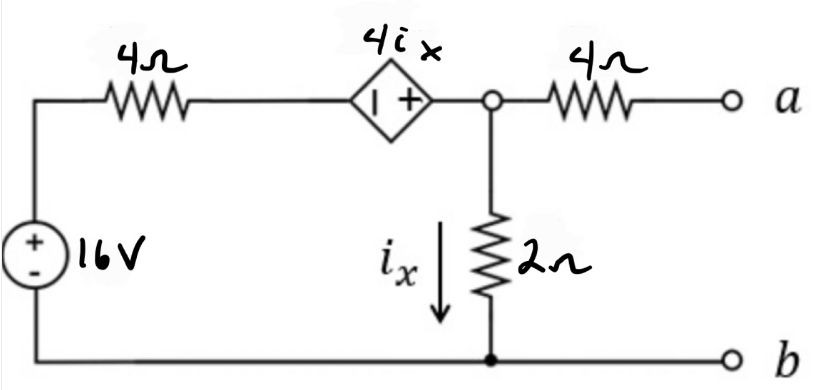Find the Norton equivalent 422 Ⓒ 16V 4ix + D ix 42 ww a ve: b
Introductory Circuit Analysis (13th Edition)
13th Edition
ISBN:9780133923605
Author:Robert L. Boylestad
Publisher:Robert L. Boylestad
Chapter1: Introduction
Section: Chapter Questions
Problem 1P: Visit your local library (at school or home) and describe the extent to which it provides literature...
Related questions
Question

Transcribed Image Text:**Objective: Find the Norton Equivalent**
**Circuit Description:**
- **Voltage Source:**
- A 16V voltage source is positioned to the left, connected in a loop.
- **Resistors:**
- **4Ω Resistor:** Situated immediately after the voltage source, in series.
- **4Ω Resistor:** Positioned on the right branch, in series with the dependent current source.
- **2Ω Resistor:** Connected vertically in a branch below the dependent source, carrying a current denoted as \( i_x \).
- **Dependent Current Source:**
- The current source is depicted as \( 4i_x \), where it is dependent on the current through the 2Ω resistor (\( i_x \)).
**Connection Points:**
- The nodes labeled \( a \) and \( b \) serve as terminals for the Norton equivalent circuit output.
**Analysis Goals:**
- To determine the Norton equivalent of the given circuit between terminals \( a \) and \( b \), which involves calculating the Norton current (\( I_N \)) and Norton resistance (\( R_N \)).
Expert Solution
Step 1
Given:
Circuit diagram,

Step by step
Solved in 3 steps with 4 images

Knowledge Booster
Learn more about
Need a deep-dive on the concept behind this application? Look no further. Learn more about this topic, electrical-engineering and related others by exploring similar questions and additional content below.Recommended textbooks for you

Introductory Circuit Analysis (13th Edition)
Electrical Engineering
ISBN:
9780133923605
Author:
Robert L. Boylestad
Publisher:
PEARSON

Delmar's Standard Textbook Of Electricity
Electrical Engineering
ISBN:
9781337900348
Author:
Stephen L. Herman
Publisher:
Cengage Learning

Programmable Logic Controllers
Electrical Engineering
ISBN:
9780073373843
Author:
Frank D. Petruzella
Publisher:
McGraw-Hill Education

Introductory Circuit Analysis (13th Edition)
Electrical Engineering
ISBN:
9780133923605
Author:
Robert L. Boylestad
Publisher:
PEARSON

Delmar's Standard Textbook Of Electricity
Electrical Engineering
ISBN:
9781337900348
Author:
Stephen L. Herman
Publisher:
Cengage Learning

Programmable Logic Controllers
Electrical Engineering
ISBN:
9780073373843
Author:
Frank D. Petruzella
Publisher:
McGraw-Hill Education

Fundamentals of Electric Circuits
Electrical Engineering
ISBN:
9780078028229
Author:
Charles K Alexander, Matthew Sadiku
Publisher:
McGraw-Hill Education

Electric Circuits. (11th Edition)
Electrical Engineering
ISBN:
9780134746968
Author:
James W. Nilsson, Susan Riedel
Publisher:
PEARSON

Engineering Electromagnetics
Electrical Engineering
ISBN:
9780078028151
Author:
Hayt, William H. (william Hart), Jr, BUCK, John A.
Publisher:
Mcgraw-hill Education,